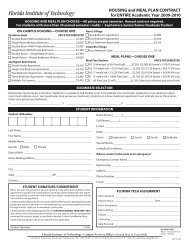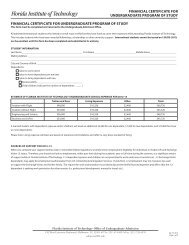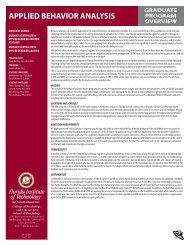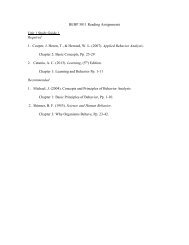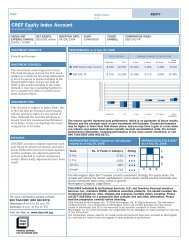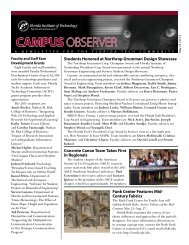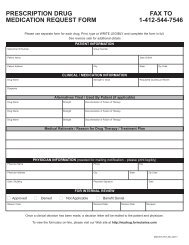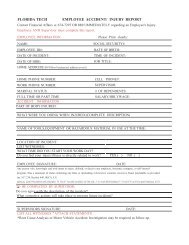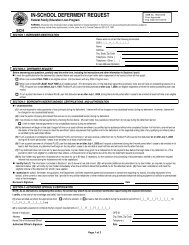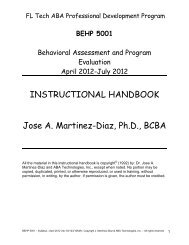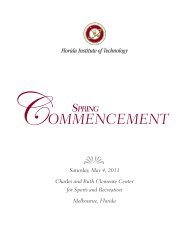2006–2007 - Florida Institute of Technology
2006–2007 - Florida Institute of Technology
2006–2007 - Florida Institute of Technology
You also want an ePaper? Increase the reach of your titles
YUMPU automatically turns print PDFs into web optimized ePapers that Google loves.
<strong>of</strong> training, and adds to the training experience. The many general<br />
aviation and commercial service airports in Central <strong>Florida</strong><br />
also <strong>of</strong>fer diversity and alternatives for flight training.<br />
Admission<br />
As a Freshman<br />
A new freshman applicant is expected to have completed a high<br />
school college-preparatory curriculum, including mathematics<br />
courses—algebra, geometry and trigonometry. Applicants are<br />
evaluated on the basis <strong>of</strong> SAT/ACT scores, high school grade<br />
point averages, class standing and grades in foundation courses<br />
such as English, science and mathematics.<br />
Tests administered to all entering freshmen during the week<br />
preceding the start <strong>of</strong> classes each semester determine appropriate<br />
placement in mathematics and English. Entering freshmen<br />
with previous flight training and at least the FAA Private Pilot<br />
Certificate will be given the opportunity for advanced placement.<br />
Credit for certain flight and ground courses may be given<br />
for attainment <strong>of</strong> satisfactory scores on designated equivalency<br />
examinations and by logbook review and flight evaluation.<br />
Students seeking admission to flight training must be examined<br />
by an FAA-designated aviation medical examiner and<br />
have an FAA medical certificate and student pilot certificate<br />
before the start <strong>of</strong> flight training. Applicants intending to seek<br />
a Commercial Pilot Certificate must have 20/20 vision in each<br />
eye, with or without correction. Medical examinations should be<br />
done far enough in advance <strong>of</strong> university admission to allow any<br />
potential problems or questions to be resolved.<br />
As a Transfer Student<br />
The College <strong>of</strong> Aeronautics welcomes transfer students from<br />
other colleges, and every effort is made to transfer the maximum<br />
number <strong>of</strong> credits. Transfer students may receive college credit<br />
for previous flight and ground training at the discretion <strong>of</strong> the<br />
division director. Transfer credit for flight training is normally<br />
granted only when the student is first enrolled, and after an<br />
evaluation that may include a flight evaluation.<br />
Dismissals<br />
Dismissal policies for academic programs <strong>of</strong> the College <strong>of</strong><br />
Aeronautics are the same as those stated in the Undergraduate<br />
Information and Regulations section <strong>of</strong> this catalog. However,<br />
due to the high-performance standards required for safety in<br />
flying, an added degree <strong>of</strong> commitment to meet those standards<br />
is required <strong>of</strong> the student pilot undergoing flight training. The<br />
dean <strong>of</strong> the College <strong>of</strong> Aeronautics retains the right to place<br />
on probation, suspend or administratively withdraw any flight<br />
student from any university flight training course, if such action<br />
is judged to be warranted by the student’s behavior.<br />
Flight Programs<br />
Flight courses for academic credit are available to all interested<br />
<strong>Florida</strong> Tech students. Prospective students interested in any<br />
university flight training should be aware <strong>of</strong> weight and height<br />
limitations that may hinder or preclude safe and effective training.<br />
Training aircraft and many other aircraft in general use<br />
cannot accommodate persons with heights <strong>of</strong> less than 60 inches<br />
or greater than 77 inches, or body weights greater than 260<br />
pounds (220 pounds for aerobatic training aircraft, which may be<br />
36 <strong>Florida</strong> Tech<br />
required for Flight Instructor training). Prospective students who<br />
may be affected by these limitations should make their situation<br />
known to admissions and the College <strong>of</strong> Aeronautics representatives<br />
at the earliest point in the application process for a case-bycase<br />
enrollment evaluation.<br />
A summer program is <strong>of</strong>fered to prospective students who have<br />
not yet started their flight training. This program <strong>of</strong>fers graduates<br />
an opportunity to become acquainted with the flight environment<br />
by participating in an intensive two-month ground and flight<br />
training course. A student who is successful in the program will<br />
earn a Private Pilot Certificate and may enter the fall semester<br />
with advance credit for Flight 1 and Aeronautics 1 (a total <strong>of</strong><br />
five semester credit hours). The credit will be applicable to all<br />
degrees <strong>of</strong>fered by the College <strong>of</strong> Aeronautics, and may be used<br />
as elective credit in many other <strong>Florida</strong> Tech degree programs.<br />
Pr<strong>of</strong>essional, vocational and recreational flight training are also<br />
provided by arrangement at the aviation center, and qualified<br />
pilots may rent university aircraft. The aviation center <strong>of</strong>fers<br />
training for FAA certificates for private, commercial and instructor<br />
pilot certificates, as well as training for the FAA ratings for<br />
instruments, multiengine, instrument instructor and multiengine<br />
instructor. An aerobatics course is also <strong>of</strong>fered.<br />
Degree Requirements<br />
Candidates for College <strong>of</strong> Aeronautics degree programs must<br />
complete the minimum course requirements as outlined in the<br />
appropriate curriculum. Deviation from the recommended program<br />
may be made only with the approval <strong>of</strong> the division director<br />
or dean.<br />
Flight Training Program<br />
The flight training sequence for the aviation management flight<br />
option consists <strong>of</strong> four courses (AVF 1001 through AVF 2002),<br />
plus four additional flight credits, at least two credits <strong>of</strong> which<br />
must be earned in a multiengine course. This program is an<br />
integrated series <strong>of</strong> courses designed to qualify the student at the<br />
end <strong>of</strong> the first two academic years for the commercial pilot certificate<br />
and an instrument rating with a minimum <strong>of</strong> 190 hours<br />
<strong>of</strong> flight training. The aeronautical science flight option requires<br />
three upper-division flight courses in addition to the four-course<br />
lower division sequence. Students enrolled in the College <strong>of</strong><br />
Aeronautics may not normally take flight training for credit outside<br />
the university’s program.<br />
A student seeking an FAA certificate or rating through the<br />
College <strong>of</strong> Aeronautics must complete courses pertinent to<br />
the desired certification at the university. To comply with FAA<br />
requirements, specific grades and attendance standards must<br />
be met in the following ground courses: Aeronautics 1 (AVT<br />
1111), Aeronautics 2 (AVT 1112), Aeronautics 3 (AVT 2111) and<br />
Instructional Techniques (AVT 3101). FAA knowledge test fees<br />
are in addition to normal course fees.<br />
Additional flight and ground training “add time,” above the basic<br />
course program, may be required to achieve certification. Costs<br />
for all such add time are in addition to regular course fees. Some<br />
students require add time to complete private pilot certification.<br />
Safety is a preeminent concern <strong>of</strong> the College <strong>of</strong> Aeronautics.<br />
All aircraft are modern, well equipped and maintained to the<br />
highest standards required by the FAA. Instructors and staff are



